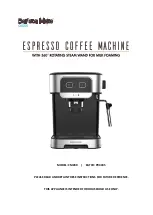
Franke Kaffeemaschinen AG
Installation | 6
User manual S700
25
– The mains water connection must meet the requirements of the technical data and comply with applicable fed-
eral, state, and local regulations.
– The mains water connection must have a backflow prevention device.
– The mains water connection must be equipped with a shut-off valve and a check valve with an upstream filter
accessible for inspection. It must be possible for the filter to be removed for cleaning.
– Water from the household decalcification system must not be used.
– Filter with at least 100 loops/inch (UL)
6.3.2
Water quality
Total hardness:
4–8° dH GH (German total hardness)
7–14° fH GH (French total hardness)
4.2–8.3 GPG
70–140 ppm (mg/l)
Carbonate hardness
3–6° dH KH / 50–105 ppm (mg/l)
Acid content/pH value
6.5–7.5 pH
Chlorine content
< 0.5 mg/l
Chloride content
< 30 mg/l
TDS (total dissolved solids)
30–150 ppm (mg/l)
Electrical conductivity (measured)
50–200 µS/cm (microsiemens)
Iron content
< 0.3 mg/l
– Color: Clear
– Taste: Fresh and pure taste
– Aroma: No perceptible aroma
– No rust particles in the water
– Reverse osmosis: The water must have a dissolved solids content of at least 30-50 ppm (30-50 mg/l) in order
to prevent the boiler being overfilled.
Evaluating the risk of corrosion
The following formula can be used for evaluation:
Calculated conductivity = measured conductivity [μS/cm] – (measured total hardness [dH GH] x constant)
– Measured conductivity in μS/cm
– Measured total hardness in dH GH
– Constant = 30 [μS/cm]/[ dH GH]
Calculated conductivity
Risk of corrosion
<200 μS/cm
low
200 – 500 μS/cm
increased
>500 μS/cm
high
Calculation example:
– Measured conductivity 700 μS/cm
– Measured total hardness 18 dH GH
– Calculated conductivity = 700 μS/cm – (18 x 30 μS/cm) = 160 μS/cm
The result of the calculation is 160 μS/cm and means that there is a low risk of corrosion.
















































